 |
Picks is a monthly sampling of Japan's art scene, offering short reviews of exhibitions at museums and galleries in recent weeks, with an emphasis on contemporary art by young artists. |
 |
 |
|
|
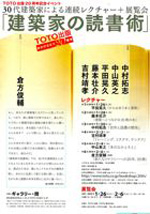 |
 |
How Architects Read
|
| 26 January - 6 February 2010 |
Gallery Ma
(Tokyo) |
 |
| This rather unusual show at one of Tokyo's premier architecture galleries had five architects in their thirties -- Hiroshi Nakamura, Hideyuki Nakayama, Akihisa Hirata, Sou Fujimoto, and Yasutaka Yoshimura -- choose 20 books each to reveal, through a series of lectures and the books themselves, what and how they read. The third-floor exhibit space was lined with chairs, a book on each one, in a novel attempt to display the thoughts and influences behind each architect's oeuvre, rather than images or models of the structures themselves. |
|
|
 |
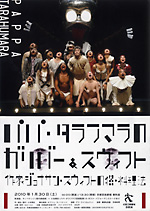 |
 |
| Pappa Tarahumara: Gulliver & Swift |
| 30 January 2010 |
Kyoto Performing Arts Center
(Kyoto) |
 |
| In this production by the innovative performing arts company Pappa Tarahumara, the audience was riveted by the fantastic stage sets conjured up by contemporary artist Kenji Yanobe. Between the amusing tricks hidden in Yanobe's props, and the airy, graceful leaping and bounding of the energetic cast across the stage, the production was mesmerizing in its beauty. |
|
|
|
|

|
 |
 |
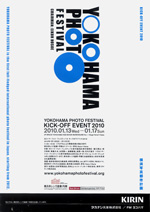 |
|
Yokohama Photo Festival Kick-Off Event 2010 |
| 13 - 17 January 2010 |
Yokohama Red Brick Warehouse Building 2
(Kanagawa) |
 |
| A prelude to the Yokohama Photo Festival's scheduled 2012 debut, this multi-day event was chaired by legendary photographer Eiko Hosoe. The first day featured a portfolio review in which some fifty artists laid their work out on tables for evaluation by a panel of gallery curators, editors, and photo directors. From the second day on this was open to the public, offering viewers the opportunity to conduct their own evaluations. |
|
|
 |
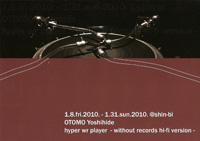 |
|
Yoshihide Otomo: hyper wr player -without records hi-fi version- |
|
|
Shin-bi
(Kyoto) |
 |
| At Kyoto Seika University's Shin-bi gallery, a single object sits in the center of the room: a record player with four arms and some weird gadgetry on the heads where the record needles would normally be. There are no LPs in sight. The four arms move seemingly at random, scratching the turntable surface to produce noise. Otomo's performance appears to be an experiment to determine what sorts of sounds can be elicited from a machine that has had its original music-reproducing function sabotaged. |
|
|
|
|
|
|
|

|
 |
 |
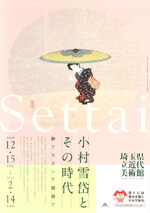 |
 |
| Settai Komura and His Era |
| 15 December 2009 - 14 February 2010 |
The Museum of Modern Art, Saitama
(Saitama) |
 |
| Born in the city of Kawagoe northwest of Tokyo, Saitama Prefecture favorite son Komura (1887-1940) was prewar Japan's ultimate renaissance man. As this retrospective conclusively demonstrates, his talents could not be constrained by his training as a Nihonga painter, but sprawled into book and magazine design and illustration, stage sets, and kimono design. The show achieves added weight and relevance by including works for comparative purposes by Komura's contemporaries Yumeji Takehisa, Kiyokata Kaburaki, Michisei Kono, and Sohachi Kimura. |
|
|
 |
 |
| Yohei Izumi: Melting Cube and Solving Sight |
| 9 - 31 January 2010 |
studio90
(Kyoto) |
 |
| A pin spotlight shines on a wall in an otherwise dark room. The light reflected from the wall fuzzily illuminates a huge cube floating in space. It is not really a cube, however, but a cubic image created by stringing 68 layers of black thread both vertically and horizontally, and painting a portion of them white. With its blurred edges and a shape that shifts subtly with the angle of view, the object truly reflects the multiple meanings of the Japanese title, Tokeyuku Shikaku (tokeyuku can mean "melt" or "solve," and shikaku can mean either "cube" or "sight"). Izumi has clearly added a kind of Op Art approach to his already burgeoning bag of tricks. |
|

|
 |
 |
 |
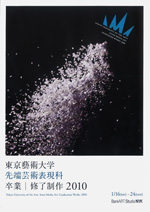 |
|
| Tokyo University of the Arts Inter-Media Art Graduation Works 2010 |
| 16 - 24 January 2010 |
BankART Studio NYK
(Kanagawa) |
 |
| Geidai's annual show of works by graduates of its Inter-Media Art Department easily fills the vast industrial spaces of BankART Studio NYK's converted warehouse on the Yokohama waterfront. Just as impressively, nearly all of it is worth a look. Continuing last year's trend away from works-in-progress, this installment emphasized works-as-finished-objects, ready to stand or fall on their own merits. A particular standout is Chinatsu Shimodaira's radial creation, composed by stringing countless rubber bands together. This mysterious construction resembles the special-effects bursts found in comic books, yet has the heft of a solid object. |
|
|
|
|
 |
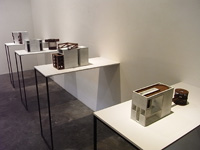 |
 |
| Aya Koizumi |
| 18 - 30 January 2010 |
Gallery Ami & Kanoko
(Osaka) |
 |
| The series that Koizumi titles "The Room Next Door" consists of white boxes that remind one of architectural models but contain a variety of odd components. Visitors are encouraged to remove these components and rearrange them as they like. Her "monado" series, on the other hand, consists of small objects constructed of Lego-like diablocks. Her minimalist forms, which employ as little manipulation of ready-made items as possible, are an aesthetically pleasing match with the matte colors of the diablocks. |
|
|
|
|
|
|
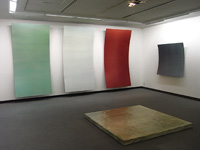 |
 |
| Sumio Shibata |
12 January - 7 February 2010
|
Gallery Nakamura
(Kyoto) |
 |
| Shibata is known for his solid objects of acrylic resin, but these new works are entirely different: flat (or semi-solid?) compositions that consist of gently curved aluminum panels sprayed with pearlescent paint. Their most compelling attribute is the way their colors change with the angle of view or the light striking them; a work that appears golden when viewed straight on gradually shifts to purple as one approaches closer. These simple forms, which at first glance seem like a type of minimal art, exude the refined fragrance of work by a veteran artist at the height of his powers. |
|
 |
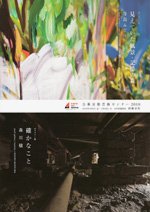 |
 |
| Kyoto Art Center Entries 2010 |
| 5 - 24 February 2010 |
Kyoto Art Center
(Kyoto) |
 |
Every year the Kyoto Art Center invites one artist to judge entries submitted for exhibition plans in two galleries. This year the judge was film director Naomi Kawase, who selected plans by Midori Terashima and Minoru Morikawa from the 126 submitted. For her "Lingering Landscape - Forest of Memory," Terashima painted a mural on the North Gallery wall over the course of the exhibition, referencing, in real time, fragments of her own memories. For his "tashika" (certainty) installation, Morikawa moved soil from under the South Gallery floor into the gallery itself. As in past years, the two winning plans and their realizations prove that these young artists bear watching.
|
|
|
|
|
 |
|